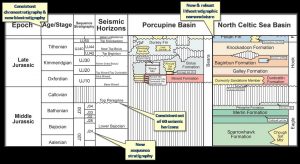Last week I was lucky enough to join the DEVEX 2024 field trip to the southern coast of the Moray Firth, NW of Aberdeen. Firstly, I have to acknowledge the superb guidance by Steve Ogilvie (Ogilvie Geoscience) and David Longstaff (Elgin Museum Geology Group). We visited outcrops of both fluviatile and aeolian dune sands, between Covesea and Burghead. The highlight for me was in discussing the geological origins and contexts of structures that would be impossible to image on seismic data and hard to identify on standard logging suites. Even though they are ‘minor’ in scale, they could have profound importance for fluid flow within the reservoir, whether that be water, hydrocarbons or CO2.

The first example is a spectacular fluid escape feature that is developed within dune sands, whereby the upper part of the outcrop is composed of rotated and imbricated blocks of dune sands, deformed whilst in a semi-consolidated state (Figure 1). Historic debate has argued between this being due to water escape or even, potentially, escaping air. Whichever mechanism is correct, the features may enhance vertical permeability in fluid flow within the reservoir that is otherwise inhibited by small scale depositional laminations and cemented zones. Structures like this could be detectable on image logs, but probably hard to interpret, especially without seeing them in outcrop!


The second highlight was a series of spectacular deformation bands within fluviatile Hopeman sandstones (Figure 2). I am much more in my comfort zone with these! Each band was formed due to ‘cataclastic’ deformation within the reservoir, whereby offset (strain) has been accommodated by crushing of the grains. Steve and Dave showed us a number of spectacular anastomosing zones of deformation bands, with each made up of dozens (or even hundreds) of individual bands (Figure 2) that weather out as pronounced ridges on the foreshore and cliff sections (Figure 3). At the seismic scale, these are likely to be associated with the Upper Jurassic rift phase within the Inner Moray Firth Basin, with its predominant WSW-ENE trend of major rift faults. Indeed, the zones of deformation bands on the beach, although variable in their strikes, often displayed slip striae that were indicative of normal extensional offsets (Figure 3), albeit with an oblique component.

The deformation bands are clearly important to reservoir heterogeneity, as they will involve a severe loss in horizontal permeability. These outcrops often showed spectacular star-like growths of barite cements, associated with the fault zones (Figure 4), which is likely to further degrade reservoir quality. This will be critical at the field scale. Anybody having worked the Central North Sea HPHT province will be familiar with innocuous looking fault zones (at seismic scale) that hold back significant pressure differentials. The De Keyser Fault Zones of the SNS may be another analogue. They were invisible to us for so long and are now just detectable on modern 3D seismic data! Merlin’s recent client work on mapping out pressure cells in the Norwegian sector (Tampen Spur) may also be an analogue, with pressure differentials held back over boundaries that are sub-seismic in nature, but seemingly parallel to the main fault trends. Deformation bands may be a factor, effectively inhibiting the equilibration of overpressures within the aquifer.
All in all, there was so much food for thought, and a reminder that outcrop geology is a necessity, not a luxury! Dave even showed us the footprints of reptiles that grazed in shallow water. I thoroughly recommend a visit to these outcrops and also the Elgin museum, where further information on the geology and local biology can be enjoyed.
Thanks again to Steve and Dave.



